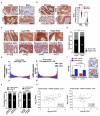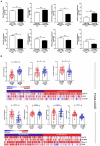Combined Estrogen Alpha and Beta Receptor Expression Has a Prognostic Significance for Colorectal Cancer Patients
- PMID: 35360718
- PMCID: PMC8963951
- DOI: 10.3389/fmed.2022.739620
Combined Estrogen Alpha and Beta Receptor Expression Has a Prognostic Significance for Colorectal Cancer Patients
Abstract
We reported that high estrogen receptor beta (ERβ) expression is independently associated with better prognosis in female colorectal cancer (CRC) patients. However, estrogen receptor alpha (ERα) is expressed at very low levels in normal colon mucosa, and its prognostic role in CRC has not been explored. Herein, we investigated the combined role of ERα and ERβ expression in the prognosis of female patients with CRC, which, to the best of our knowledge, is the first study to investigate this topic. A total number of 306 primary CRCs were immunostained for ERα and ERβ expression. A Cox regression model was used to evaluate overall survival (OS) and disease-free survival (DFS). The combined expression of high ERβ + negative ERα correlates with longer OS (HR = 0.23; 95% CI: 0.11-0.45, P <0.0001) and DFS (HR = 0.10; 95% CI: 0.03-0.26, P < 0.0001) and a more favorable tumor outcome, as well as significantly higher expression of antitumorigenic proteins than combined expression of low ERβ + positive ERα. Importantly, we found that low ERβ expression was associated with local recurrence of CRC, whereas ERα expression was correlated with liver metastasis. Overall, our results show that the combined high ERβ + negative ERα expression correlated with a better prognosis for CRC patients. Our results suggest that the combined expression of ERα and ERβ could be used as a predictive combination marker for CRC patients, especially for predicting DFS.
Keywords: CRC disease-free survival; CRC overall survival; colorectal cancer; estrogen receptor alpha; estrogen receptor beta.
Copyright © 2022 Topi, Ghatak, Satapathy, Ehrnström, Lydrup and Sjölander.
Conflict of interest statement
The authors declare that the research was conducted in the absence of any commercial or financial relationships that could be construed as a potential conflict of interest.
Figures







Similar articles
-
The prognostic values of estrogen receptor alpha and beta in patients with gastroesophageal cancer: A meta-analysis.Medicine (Baltimore). 2019 Nov;98(46):e17954. doi: 10.1097/MD.0000000000017954. Medicine (Baltimore). 2019. PMID: 31725654 Free PMC article.
-
Expression of estrogen receptor beta in human colorectal cancer.World J Gastroenterol. 2004 Jan 15;10(2):214-7. doi: 10.3748/wjg.v10.i2.214. World J Gastroenterol. 2004. PMID: 14716825 Free PMC article.
-
Sex-specific differences in the expression levels of estrogen receptor subtypes in colorectal cancer.Gend Med. 2008 Sep;5(3):209-17. doi: 10.1016/j.genm.2008.07.005. Gend Med. 2008. PMID: 18727987
-
Association Between Estrogen Receptors and GATA3 in Bladder Cancer: A Systematic Review and Meta-Analysis of Their Clinicopathological Significance.Front Endocrinol (Lausanne). 2021 Oct 8;12:684140. doi: 10.3389/fendo.2021.684140. eCollection 2021. Front Endocrinol (Lausanne). 2021. PMID: 34690921 Free PMC article.
-
Clinical significance of estrogen receptor beta in breast cancer.Cancer Chemother Pharmacol. 2005 Nov;56 Suppl 1:21-6. doi: 10.1007/s00280-005-0107-3. Cancer Chemother Pharmacol. 2005. PMID: 16273360 Review.
Cited by
-
Delineating the role of nuclear receptors in colorectal cancer, a focused review.Discov Oncol. 2024 Feb 19;15(1):41. doi: 10.1007/s12672-023-00808-x. Discov Oncol. 2024. PMID: 38372868 Free PMC article. Review.
-
Regional and Gender-Based Distribution of KRAS Mutations in Metastatic Colorectal Cancer Patients in Turkey: An Observational Study.Medicina (Kaunas). 2025 Apr 10;61(4):694. doi: 10.3390/medicina61040694. Medicina (Kaunas). 2025. PMID: 40282985 Free PMC article.
-
Intricate roles of estrogen and estrogen receptors in digestive system cancers: a systematic review.Cancer Biol Med. 2024 Oct 30;21(10):898-915. doi: 10.20892/j.issn.2095-3941.2024.0224. Cancer Biol Med. 2024. PMID: 39475214 Free PMC article.
-
Sex Differences in Colon Cancer: Genomic and Nongenomic Signalling of Oestrogen.Genes (Basel). 2023 Dec 16;14(12):2225. doi: 10.3390/genes14122225. Genes (Basel). 2023. PMID: 38137047 Free PMC article. Review.
-
High Oestrogen receptor alpha expression correlates with adverse prognosis and promotes metastasis in colorectal cancer.Cell Commun Signal. 2024 Mar 28;22(1):198. doi: 10.1186/s12964-024-01582-1. Cell Commun Signal. 2024. PMID: 38549115 Free PMC article.
References
-
- Konstantinopoulos PA, Kominea A, Vandoros G, Sykiotis GP, Andricopoulos P, Varakis I, et al. . Oestrogen receptor beta (ERbeta) is abundantly expressed in normal colonic mucosa, but declines in colon adenocarcinoma paralleling the tumour's dedifferentiation. Eur J Cancer. (2003) 39:1251–8. 10.1016/S0959-8049(03)00239-9 - DOI - PubMed
LinkOut - more resources
Full Text Sources

